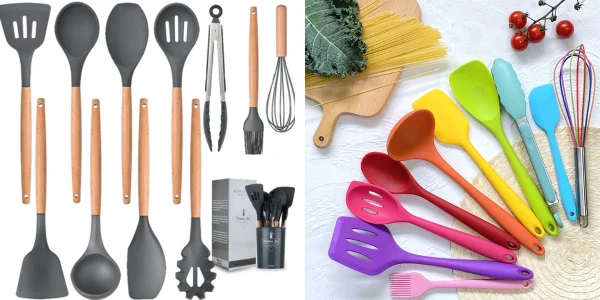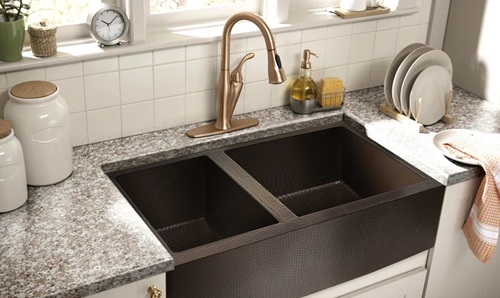When it comes to choosing the right cooking utensils for your kitchen, the material you select can significantly impact your cooking experience, food safety, and even the longevity of your cookware. Two popular options are silicone and plastic cooking utensils. While both offer affordability and convenience, they have distinct differences that can influence your decision.
In this detailed comparison, we’ll break down the key aspects of silicone and plastic utensils, including their durability, heat resistance, safety, and more — helping you decide which option suits your kitchen best.
Overview of Silicone and Plastic Cooking Utensils
Silicone Cooking Utensils
Silicone utensils are made from food-grade silicone, a rubber-like material that is flexible, heat-resistant, and non-toxic. These utensils are widely popular for their versatility and ability to protect non-stick cookware.
Plastic Cooking Utensils
Plastic utensils are made from various types of polymer-based materials. While lightweight and affordable, plastic utensils may have limitations in high-heat cooking situations.
Key Differences Between Silicone and Plastic Utensils
![]()
a) Heat Resistance
- Silicone Utensils: Silicone can typically withstand temperatures up to 450°F to 600°F (232°C to 315°C), making it ideal for stirring hot soups, flipping pancakes, or sautéing. Silicone won’t melt or deform easily.
- Plastic Utensils: Plastic utensils generally have a lower heat resistance, often withstanding temperatures up to 200°F to 300°F (93°C to 149°C). When exposed to high heat, plastic can melt, warp, or even release harmful chemicals.
✅ Winner: Silicone for superior heat resistance.
b) Durability and Longevity
- Silicone Utensils: Silicone utensils are flexible, non-cracking, and non-corrosive. They maintain their shape and texture even with frequent use.
- Plastic Utensils: Plastic utensils are more prone to cracking, breaking, or warping over time, especially if frequently exposed to heat or pressure.
✅ Winner: Silicone for better durability.
c) Food Safety
- Silicone Utensils: High-quality food-grade silicone is BPA-free, non-toxic, and does not release harmful chemicals when heated.
- Plastic Utensils: Some plastic utensils, especially those made from low-quality plastic, may contain BPA, phthalates, or other chemicals that can leach into food when exposed to heat.
✅ Winner: Silicone for enhanced food safety.
d) Flexibility and Versatility
- Silicone Utensils: Silicone’s flexible nature makes it perfect for scraping bowls, folding batter, or reaching tight corners of cookware.
- Plastic Utensils: Plastic utensils are often rigid, limiting their ability to handle delicate tasks like scraping or folding.
✅ Winner: Silicone for greater flexibility.
e) Non-Stick Cookware Compatibility
- Silicone Utensils: Silicone is soft and non-abrasive, making it safe to use on non-stick pans, ceramic cookware, and glass surfaces without causing scratches.
- Plastic Utensils: While plastic is generally soft, certain hard plastic edges can still cause minor scratches on delicate cookware.
✅ Winner: Silicone for better non-stick cookware protection.
f) Cleaning and Maintenance
- Silicone Utensils: Silicone utensils are often dishwasher-safe, stain-resistant, and easy to clean.
- Plastic Utensils: Plastic utensils can absorb food stains and odors over time, requiring more effort to keep them clean.
✅ Winner: Silicone for easier cleaning and maintenance.
g) Design and Aesthetics
- Silicone Utensils: Available in a wide range of colors, shapes, and designs, silicone utensils can enhance your kitchen’s appearance.
- Plastic Utensils: While plastic utensils also come in various colors, their appearance may degrade faster with scratches, discoloration, or warping.
✅ Winner: Silicone for more stylish and long-lasting designs.
h) Cost
- Silicone Utensils: Typically slightly more expensive than plastic but offer better durability and performance.
- Plastic Utensils: Known for their affordability, plastic utensils are a budget-friendly option for occasional use.
✅ Winner: Plastic for affordability.
i) Environmental Impact
- Silicone Utensils: While silicone is non-toxic and longer-lasting, it is not biodegradable. However, its durability reduces the need for frequent replacements.
- Plastic Utensils: Plastic utensils contribute significantly to plastic waste, especially if they crack or melt easily.
✅ Winner: Silicone for reduced environmental impact due to longevity.
Pros and Cons of Silicone Cooking Utensils
Pros
✅ Highly heat-resistant (up to 600°F)
✅ Non-toxic and BPA-free
✅ Gentle on non-stick cookware
✅ Flexible and versatile
✅ Dishwasher-safe and easy to clean
Cons
❌ Slightly more expensive than plastic
❌ Can be prone to tearing or cutting if misused
Pros and Cons of Plastic Cooking Utensils
Pros
✅ Affordable and widely available
✅ Lightweight and easy to handle
✅ Available in various shapes and colors
Cons
❌ Prone to melting, warping, or cracking
❌ May contain harmful chemicals like BPA
❌ Can absorb stains and odors
Which Option is Better for Different Cooking Needs?
Choose Silicone Utensils If:
✔️ You frequently cook at high temperatures
✔️ You use non-stick cookware and want to prevent scratches
✔️ You prefer easy-to-clean utensils with minimal maintenance
Choose Plastic Utensils If:
✔️ You’re looking for an affordable, temporary solution
✔️ You need utensils for cold dishes, salads, or baking preparation
✔️ You don’t cook at high temperatures frequently
Cost Comparison: Silicone vs Plastic Utensils
| Feature | Silicone Utensils | Plastic Utensils |
|---|---|---|
| Initial Cost | Slightly higher | Budget-friendly |
| Heat Resistance | Up to 600°F | Up to 300°F |
| Durability | Excellent | Moderate (Prone to damage) |
| Food Safety | BPA-free, Non-toxic | May contain chemicals |
| Maintenance | Easy to clean, dishwasher-safe | May stain or absorb odors |
| Design Variety | Wide range of colors & styles | Limited design durability |
Final Verdict: Which One is Better?
While both silicone and plastic utensils have their benefits, silicone utensils generally offer superior performance in terms of heat resistance, durability, and food safety.
If you prioritize affordability and only need utensils for low-heat cooking or cold food preparation, plastic utensils can still be a practical choice.
For long-term value, improved safety, and versatility in cooking, silicone utensils are the better investment for modern kitchens.
Expert Tip for Kitchen Owners
When purchasing silicone utensils, always look for 100% food-grade silicone labeled as BPA-free and FDA-approved to ensure safety. Avoid cheap silicone blends that may contain fillers or harmful additives.
By choosing wisely based on your cooking habits and kitchen needs, you can enjoy safe, efficient, and long-lasting cooking experiences.


